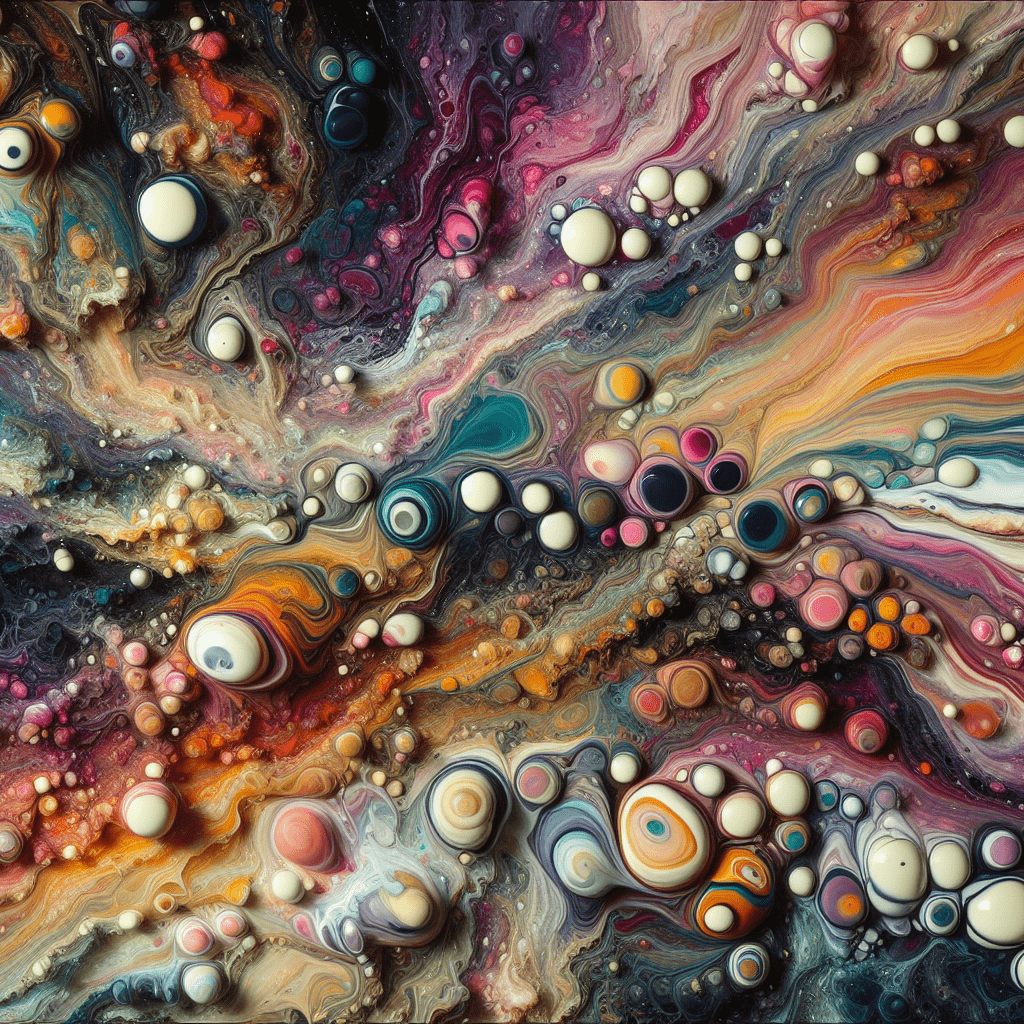This article is a guide to understanding acrylic paint bodies for paint pouring. It explains the differences between heavy, soft, and medium-bodied paints and how they can impact your pour technique and final artwork. By understanding paint consistency and flow, you can choose the right acrylics to elevate your art.

What Are Acrylic Paint Bodies?
Acrylic paint bodies refer to the viscosity, or thickness, of acrylic paints. Different viscosities result in varying textures and behaviors during the paint pouring process. By comprehending the characteristics and applications of each type, you can better control your art and achieve the desired effects.
Types of Acrylic Paint Bodies
To get started, let’s break down the three primary types of acrylic paint bodies:
- Heavy Body Acrylics
- Soft Body Acrylics
- Fluid Acrylics
Each type offers unique properties, which can be both an asset and a challenge depending on your artistic vision and technique.
Heavy Body Acrylics
Heavy Body Acrylics are the thickest and most viscous of the three types. They have a rich, buttery consistency, making them ideal for traditional brush painting and knife techniques.
Characteristics of Heavy Body Acrylics
Heavy Body Acrylics are known for their texture and retention of brush strokes. Here’s a closer look at their key features:
| Characteristic | Description |
|---|---|
| Viscosity | Thick and buttery |
| Pigment Load | High, offering vibrant and deep colors |
| Mixing Ability | Less fluid, requiring mediums or water for pouring |
| Application | Best for impasto effects and textured applications |
Uses in Paint Pouring
Using Heavy Body Acrylics in paint pouring can be challenging due to their thickness. However, they can create striking textures and depth when properly mixed with pouring mediums. The key is to add enough medium to achieve the right consistency without diluting the colors too much.
Soft Body Acrylics
Soft Body Acrylics strike a balance between Heavy Body and Fluid Acrylics. They offer a smooth consistency that is thick enough to hold shape but flows more easily than Heavy Body Acrylics.
Characteristics of Soft Body Acrylics
Soft Body Acrylics are versatile and adaptable for various techniques. Here are some key characteristics:
| Characteristic | Description |
|---|---|
| Viscosity | Smooth and slightly thick |
| Pigment Load | High, with vibrant, saturated colors |
| Mixing Ability | Easier to mix with mediums than Heavy Body Acrylics |
| Application | Suitable for both detailed work and flowing techniques |
Uses in Paint Pouring
For paint pouring, Soft Body Acrylics offer an excellent balance. They don’t require as much medium to achieve a pourable consistency, which helps maintain color vibrancy and simplifies the process.
Fluid Acrylics
Fluid Acrylics are the least viscous, resembling the consistency of heavy cream. They are specifically designed for pourable applications, offering excellent flow and smoothness.
Characteristics of Fluid Acrylics
Fluid Acrylics are perfect for creating seamless pours and intricate patterns. Let’s explore their main features:
| Characteristic | Description |
|---|---|
| Viscosity | Thin and runny, like heavy cream |
| Pigment Load | High, providing intense and bold colors |
| Mixing Ability | Easily combines with other fluids and mediums |
| Application | Ideal for fluid art, glazing, and detailed line work |
Uses in Paint Pouring
Fluid Acrylics are a favorite among paint pouring enthusiasts due to their ease of use. They require less medium to adjust consistency, retaining vibrant colors and delivering smoother, more dynamic pours.

Choosing the Right Acrylic Paint Body for Your Project
Selecting the appropriate paint body depends on your desired outcome and specific project needs. Here are some decision-making tips:
Consider Your Technique
Different paint techniques perform better with certain acrylic bodies. Understanding your preferred technique can guide you in selecting the optimal paint body.
- Impasto and Textural Work: Heavy Body Acrylics maintain their shape and texture, enhancing the depth.
- Smooth and Detailed Lines: Soft Body Acrylics flow well but hold enough consistency for controlled application.
- Fluid Art and Pouring: Fluid Acrylics provide the best results with minimal adjustments.
Think About the Finished Look
Your vision for the final piece plays a crucial role in picking the right paint body. Do you want a textured or smooth finish? Bold color blocks or intricate swirls? Align your paint choice with your artistic goals.
Mixing and Adjusting Consistency
Each paint body can be altered with a variety of mediums. Experimenting with different combinations allows you to discover new effects and enhance the versatility of your paints.
Mastering Paint Pouring Techniques
Once you understand the types of acrylic paint bodies, the next step is to master the actual pouring techniques. Here’s a detailed look at popular methods:
Dirty Pour
Combine multiple colors in a single cup before pouring onto the canvas. This technique creates naturally blending patterns and random swirls.
Flip Cup
Place a filled cup of paint on the canvas and then flip it over. Lift the cup slowly to let the paint flow out, creating intriguing layers.
Puddle Pour
Pour individual colors onto the canvas, creating small puddles. Tilt the canvas to blend the colors and form patterns.
Swipe Technique
Apply several colors on the canvas and use a swiping tool, such as a palette knife, to drag the paint across, creating waves and cells.
Common Challenges and Solutions
Paint pouring, while mesmerizing, comes with its set of challenges. Here are some common issues and how to tackle them:
Cell Formation
Cells are created when different densities in paint and mediums react. If you want more cells:
- Use silicone oil; a few drops can produce striking effects.
- Layer paints with varying consistencies.
- Torch the surface lightly to enhance cell formation.
Cracking and Crazing
Cracks may appear as the paint dries. Prevent this by:
- Ensuring a consistent thickness in your paint layers.
- Using proper ratios of pouring medium to paint.
- Allowing the final piece to dry in a stable, dust-free environment.
Color Muddying
Colors can become muddy if they mix too much:
- Limit the number of colors used.
- Increase the viscosity of your paints to reduce blending.
- Pour carefully to maintain distinct color boundaries.
The Role of Pouring Mediums
Pouring mediums play a vital role in paint pouring, helping thin the paint while maintaining its integrity. Here are popular types of pouring mediums:
| Medium Type | Description |
|---|---|
| Acrylic Pouring Medium | Designed to mix with acrylic paints for smooth pouring |
| PVA Glue | An economical alternative, but may affect color vibrancy |
| Mod Podge | Adds a glossy finish but may reduce color saturation |
Experiment with these mediums to see which works best for your projects.
Cleaning Up After a Pour
Cleaning up after a paint pour is essential to maintain your tools and workspace. Here are some tips:
Wet Paint Cleanup
- Use a palette knife or scraper to remove excess paint.
- Wipe surfaces with a damp cloth quickly to prevent drying.
Dried Paint Cleanup
- Soak brushes and tools in water or a brush cleaner to loosen dried paint.
- For stubborn areas, gently scrub with a brush cleaner.
Environmental Considerations
Disposal of paint waste should be done responsibly. Avoid pouring excess paint down the sink. Let it dry and dispose of it with solid waste.
Conclusion
Understanding the different acrylic paint bodies sets the foundation for exploring the artistic and exciting world of paint pouring. Whether you prefer the rich texture of Heavy Body Acrylics, the smooth flow of Soft Body Acrylics, or the seamless pour with Fluid Acrylics, each type can be harnessed to create captivating works of art. Delve into the techniques, mediums, and best practices to elevate your paint pouring experience and turn your creative visions into vibrant reality. Happy pouring!

